
Willem Barents
Encyclopedia
Willem Barentsz (c. 1550 – 20 June 1597) was a Dutch
navigator
, cartographer, explorer, and a leader of early expeditions to the far north.
The Barents Sea
, Barentsburg
and Barents Region
were all named after him.
in the Seventeen Provinces
.
A cartographer by trade, Barentsz sailed to Spain and the Mediterranean to complete an atlas
of the Mediterranean region, which he co-published with Petrus Plancius
.
His career as an explorer was spent searching for the Northeast passage, which he reasoned must exist as clear, open water north of Siberia
since the sun shone 24 hours a day
, which he believed would have melted any potential ice.
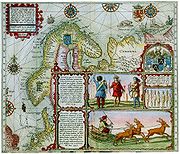 On 5 June 1594 Barentsz left the island of Texel
On 5 June 1594 Barentsz left the island of Texel
aboard the small ship Mercury, as part of a group of three ships sent out in separate directions to try and enter the Kara Sea
, with the hopes of finding the Northeast passage above Siberia
. Between 23 and 29 June, Barentsz stayed at Kildin Island
.
On 9 July, the crew encountered a polar bear
for the first time. After shooting it with a musket
when it tried to climb aboard the ship, the seamen decided to capture it with the hope of bringing it back to Holland. Once leashed and brought aboard the ship however, the bear rampaged
and had to be killed. This occurred in Bear Creek, Williams Island.
Upon discovering the Orange Islands, the crew came across a herd of approximately 200 walrus
es and tried to kill them with hatchets and pikes. Finding the task more difficult than they imagined, they left with only a few ivory tusks.
Barentsz reached the west coast of Novaya Zemlya
, and followed it northward before being forced to turn back in the face of large icebergs. Although they did not reach their ultimate goal, the trip was considered a success.
.jpg) The following year, Prince Maurice of Orange
The following year, Prince Maurice of Orange
was filled with "the most exaggerated hopes" on hearing of Barentsz' previous voyage, and named him Chief Pilot and Conductor of a new expedition, which was accompanied by six ships loaded with merchant wares that the Dutch hoped to trade with China.
Setting out on 2 June 1595, the voyage went between the Siberian coast and Vaygach Island. On 30 August, the party came across approximately 20 Samoyed
"wild men" with whom they were able to speak, due to a crewmember speaking their language. 4 September saw a small crew sent to States Island to search for a type of crystal
that had been noticed earlier. The party was attacked by a polar bear, and two sailors were killed.
Eventually, the expedition turned back upon discovering that unexpected weather had left the Kara Sea
frozen. This expedition was largely considered to be a failure.
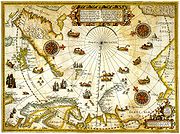 In 1596, disappointed by the failure of previous expeditions, the States-General announced they would no longer subsidize
In 1596, disappointed by the failure of previous expeditions, the States-General announced they would no longer subsidize
similar voyages - but instead offered a high reward for anybody who successfully navigated the Northeast Passage.
The Town Council of Amsterdam
purchased and outfitted two small ships, captained by Jan Rijp
and Jacob van Heemskerk
, to search for the elusive channel under the command of Barentsz. They set off on 10 May or 15 May, and on 9 June discovered Bear Island.
They discovered Spitsbergen
on 17 June, sighting its northwest coast. On 20 June they saw the entrance of a large bay, later called Raudfjorden
. On 21 June they anchored between Cloven Cliff and Vogelsang, where they "set up a post with the arms of the Dutch upon it." On 25 June they entered Magdalenefjorden
, which they named Tusk Bay, in light of the walrus tusks they found there. The following day, 26 June, they sailed into the northern entrance of Forlandsundet
, which they simply called Keerwyck, but were forced to turn back because of a shoal. On 28 June they rounded the northern point of Prins Karls Forland, which they named Vogelhoek, on account of the large number of birds they saw there. They sailed south, passing Isfjorden and Bellsund
, which were labelled on Barentsz's chart as Grooten Inwyck and Inwyck.
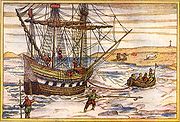 The ships once again found themselves at Bear Island on 1 July, which led to a disagreement between Barentsz and Van Heemskerk on one side and Rijp on the other. They agreed to part ways, with Barentsz continuing northeast, while Rijp headed due north. Barentsz reached Novaya Zemlya
The ships once again found themselves at Bear Island on 1 July, which led to a disagreement between Barentsz and Van Heemskerk on one side and Rijp on the other. They agreed to part ways, with Barentsz continuing northeast, while Rijp headed due north. Barentsz reached Novaya Zemlya
on 17 July. Anxious to avoid becoming entrapped in the surrounding ice, he intended to head for the Vaigatch Strait, but became stuck within the many icebergs and floes.
Stranded, the 16-man crew was forced to spend the winter on the ice, along with their young cabin boy
. After a failed attempt to melt the permafrost
, the crew used lumber from their ship to build a 7.8x5.5 metre lodge they called Het Behouden Huys (The Rescued House).
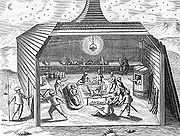 Dealing with extreme cold, the crew realised that their socks would burn before their feet could even feel the warmth of a fire - and took to sleeping with warmed stones and cannonballs. In addition, they used the merchant fabrics aboard the ship to make additional blankets and clothing.
Dealing with extreme cold, the crew realised that their socks would burn before their feet could even feel the warmth of a fire - and took to sleeping with warmed stones and cannonballs. In addition, they used the merchant fabrics aboard the ship to make additional blankets and clothing.
The ship bore salted beef, butter, cheese, bread, barley, peas, beans, groats
, flour, oil, vinegar, mustard, salt, beer, wine, brandy, hardtack
, smoked bacon, ham and fish. Much of the beer froze, bursting the cask
s. By 8 November Gerrit de Veer
, the ships carpenter who kept a diary, reported a shortage of beer and bread, with wine being rationed four days later.
In January 1597, De Veer became the first person to witness and record the atmospheric anomaly known as the Novaya Zemlya effect
.
 Proving successful at hunting, the group caught 26 arctic fox
Proving successful at hunting, the group caught 26 arctic fox
es in primitive traps, as well as killing a number of polar bears.
When June arrived, and the ice had still not loosened its grip on the ship, the scurvy
-ridden survivors took two small boats out into the sea on 13 June. Barentsz died at sea on 20 June 1597, while studying charts only seven days after starting out. It is not known whether Barentsz was buried on the northern island of Novaya Zemlya
, or at sea. It took seven more weeks for the boats to reach the Kola Peninsula
where they were rescued by a Russian merchant vessel, and by that time only 12 crewmen remained. Ultimately, they did not reach Amsterdam until 1 November. Sources differ on whether two men died on the ice floe and three in the boats, or three on the ice floe and two in the boats. The young cabin boy had died during the winter months in the shelter.
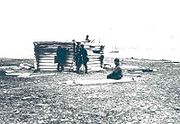 The wooden lodge where Barentsz' crew sheltered was found undisturbed by Norwegian seal hunter Elling Carlsen
The wooden lodge where Barentsz' crew sheltered was found undisturbed by Norwegian seal hunter Elling Carlsen
in 1871. Making a sketch of the lodge's construction, Carlsen recorded finding two copper cooking pots, a barrel, a tool chest, clock, crowbar, flute, clothing, two empty chests, a cooking tripod and a number of pictures. Captain Gunderson landed at the site on 17 August 1875 and collected a grappling iron, two maps and a handwritten translation of Pet and Jackman's voyages. The following year, Charles L.W. Gardiner also visited the site on 29 July where he collected 112 more objects, including the message by Barentsz and Heemskerck describing their settlement to future visitors. All of these objects eventually ended up in the Rijksmuseum Amsterdam, after some had initially been held in The Hague
.
 The amateur archaeologist Miloradovich 's 1933 finds are held in the Arctic and Antarctic Museum
The amateur archaeologist Miloradovich 's 1933 finds are held in the Arctic and Antarctic Museum
in St. Petersburg Dmitriy Kravchenko visited the site in 1977, 1979 and 1980 - and sent divers into the sea hoping to find the wreck of the large ship. He returned with a number of objects, which went to the Russian Arkangel's Regional Museum. Another small collection exists at the Polar Museum in Tromsø
.
In 1992, an expedition of three scientists, a journalist and two photographers commissioned by the Arctic Centre at the University of Groningen
, coupled with two scientists, a cook and a doctor sent by the Arctic and Antarctic Research Institute
in St. Petersburg, returned to the site, and erected a commemorative marker at the site of the cabin.
The location of Barentsz' wintering on the ice floes has become a tourist destination for icebreaker
cruiseships operating from Murmansk
.
who had accompanied him on the first two voyages, and Gerrit de Veer
who had acted as the ship's carpenter on the last two voyages.
In 1853, the former Murmean Sea was renamed Barents Sea
in his honour.
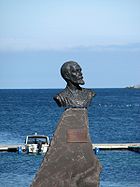 In the late 19th century, the Maritime Institute Willem Barents was opened on Terschelling
In the late 19th century, the Maritime Institute Willem Barents was opened on Terschelling
.
In 1878, the Netherlands christened
the Willem Barentsz Arctic exploration ship.
In 1931, Nijgh & Van Ditmar published a play written by Albert Helman about Barentsz' third voyage, although it was never performed.
In 1946, the Whaling ship
Pan Gothia was re-christened the Willem Barentsz. In 1953, the second Willem Barentsz whaling ship was produced.
A protein
in the molecular structure of the fruit fly
was named Barentsz, in honour of the explorer.
Dutch filmmaker Reinout Oerlemans
is currently shooting a film to be called Nova Zembla
which will be released in November 2011. It is the first Dutch 3D feature film.
Dutch Republic
The Dutch Republic — officially known as the Republic of the Seven United Netherlands , the Republic of the United Netherlands, or the Republic of the Seven United Provinces — was a republic in Europe existing from 1581 to 1795, preceding the Batavian Republic and ultimately...
navigator
Navigator
A navigator is the person on board a ship or aircraft responsible for its navigation. The navigator's primary responsibility is to be aware of ship or aircraft position at all times. Responsibilities include planning the journey, advising the Captain or aircraft Commander of estimated timing to...
, cartographer, explorer, and a leader of early expeditions to the far north.
The Barents Sea
Barents Sea
The Barents Sea is a marginal sea of the Arctic Ocean, located north of Norway and Russia. Known in the Middle Ages as the Murman Sea, the sea takes its current name from the Dutch navigator Willem Barents...
, Barentsburg
Barentsburg
Barentsburg is the second largest settlement on Svalbard, with about 500 inhabitants , almost entirely Russians and Ukrainians. The Russian-owned Arktikugol has been mining coal here since 1932.-Status:...
and Barents Region
Barents Region
The Barents Region is a name given, by political ambition to establish international cooperation after the fall of the Soviet Union, to the land along the coast of the Barents Sea, from Nordland in Norway to the Kola Peninsula in Russia and beyond all the way to the Ural Mountains and Novaya...
were all named after him.
Life
Willem Barentsz was born around the year 1550 on the island TerschellingTerschelling
Terschelling is a municipality and an island in the northern Netherlands, one of the West Frisian Islands.Waddenislanders are known for their resourcefulness in using anything and everything that washes ashore. With few trees to use for timber, most of the farms and barns are built with masts...
in the Seventeen Provinces
Seventeen Provinces
The Seventeen Provinces were a personal union of states in the Low Countries in the 15th century and 16th century, roughly covering the current Netherlands, Belgium, Luxembourg, a good part of the North of France , and a small part of Western Germany.The Seventeen Provinces were originally held by...
.
A cartographer by trade, Barentsz sailed to Spain and the Mediterranean to complete an atlas
Atlas
An atlas is a collection of maps; it is typically a map of Earth or a region of Earth, but there are atlases of the other planets in the Solar System. Atlases have traditionally been bound into book form, but today many atlases are in multimedia formats...
of the Mediterranean region, which he co-published with Petrus Plancius
Petrus Plancius
Petrus Plancius was a Dutch astronomer, cartographer and clergyman. He was born as Pieter Platevoet in Dranouter, now in Heuvelland, West Flanders. He studied theology in Germany and England...
.
His career as an explorer was spent searching for the Northeast passage, which he reasoned must exist as clear, open water north of Siberia
Siberia
Siberia is an extensive region constituting almost all of Northern Asia. Comprising the central and eastern portion of the Russian Federation, it was part of the Soviet Union from its beginning, as its predecessor states, the Tsardom of Russia and the Russian Empire, conquered it during the 16th...
since the sun shone 24 hours a day
Land of the Midnight Sun
The Land of the Midnight Sun may refer to any of the world's northern regions above the Arctic Circle including:* Canada, including the Yukon, Northwest Territories, and Nunavut* Denmark * Finland* Iceland* Lapland* Norway* Russia* Sweden...
, which he believed would have melted any potential ice.
First voyage

Texel
Texel is a municipality and an island in the Netherlands, in the province of North Holland. It is the biggest and most populated of the Frisian Islands in the Wadden Sea, and also the westernmost of this archipelago, which extends to Denmark...
aboard the small ship Mercury, as part of a group of three ships sent out in separate directions to try and enter the Kara Sea
Kara Sea
The Kara Sea is part of the Arctic Ocean north of Siberia. It is separated from the Barents Sea to the west by the Kara Strait and Novaya Zemlya, and the Laptev Sea to the east by the Severnaya Zemlya....
, with the hopes of finding the Northeast passage above Siberia
Siberia
Siberia is an extensive region constituting almost all of Northern Asia. Comprising the central and eastern portion of the Russian Federation, it was part of the Soviet Union from its beginning, as its predecessor states, the Tsardom of Russia and the Russian Empire, conquered it during the 16th...
. Between 23 and 29 June, Barentsz stayed at Kildin Island
Kildin Island
Kildin is a small Russian island in the Barents Sea, off the Russian shore and about 120 km from Norway. Administratively, Kildin belongs to the Murmansk Oblast of the Russian Federation....
.
On 9 July, the crew encountered a polar bear
Polar Bear
The polar bear is a bear native largely within the Arctic Circle encompassing the Arctic Ocean, its surrounding seas and surrounding land masses. It is the world's largest land carnivore and also the largest bear, together with the omnivorous Kodiak Bear, which is approximately the same size...
for the first time. After shooting it with a musket
Musket
A musket is a muzzle-loaded, smooth bore long gun, fired from the shoulder. Muskets were designed for use by infantry. A soldier armed with a musket had the designation musketman or musketeer....
when it tried to climb aboard the ship, the seamen decided to capture it with the hope of bringing it back to Holland. Once leashed and brought aboard the ship however, the bear rampaged
Running amok
Running amok, sometimes referred to as simply amok is a term for a killing spree perpetrated by an individual out of rage or resentment over perceived mistreatment....
and had to be killed. This occurred in Bear Creek, Williams Island.
Upon discovering the Orange Islands, the crew came across a herd of approximately 200 walrus
Walrus
The walrus is a large flippered marine mammal with a discontinuous circumpolar distribution in the Arctic Ocean and sub-Arctic seas of the Northern Hemisphere. The walrus is the only living species in the Odobenidae family and Odobenus genus. It is subdivided into three subspecies: the Atlantic...
es and tried to kill them with hatchets and pikes. Finding the task more difficult than they imagined, they left with only a few ivory tusks.
Barentsz reached the west coast of Novaya Zemlya
Novaya Zemlya
Novaya Zemlya , also known in Dutch as Nova Zembla and in Norwegian as , is an archipelago in the Arctic Ocean in the north of Russia and the extreme northeast of Europe, the easternmost point of Europe lying at Cape Flissingsky on the northern island...
, and followed it northward before being forced to turn back in the face of large icebergs. Although they did not reach their ultimate goal, the trip was considered a success.
Second voyage
.jpg)
Maurice of Nassau, Prince of Orange
Maurice of Nassau, Prince of Orange was sovereign Prince of Orange from 1618, on the death of his eldest half brother, Philip William, Prince of Orange,...
was filled with "the most exaggerated hopes" on hearing of Barentsz' previous voyage, and named him Chief Pilot and Conductor of a new expedition, which was accompanied by six ships loaded with merchant wares that the Dutch hoped to trade with China.
Setting out on 2 June 1595, the voyage went between the Siberian coast and Vaygach Island. On 30 August, the party came across approximately 20 Samoyed
Samoyedic peoples
The term Samoyedic peoples is used to describe peoples speaking Samoyedic languages, which are part of the Uralic family. They are a linguistic grouping, not an ethnic or cultural one. The name derives from the obsolete term Samoyed used in Russia for some indigenous peoples of Siberia...
"wild men" with whom they were able to speak, due to a crewmember speaking their language. 4 September saw a small crew sent to States Island to search for a type of crystal
Crystal
A crystal or crystalline solid is a solid material whose constituent atoms, molecules, or ions are arranged in an orderly repeating pattern extending in all three spatial dimensions. The scientific study of crystals and crystal formation is known as crystallography...
that had been noticed earlier. The party was attacked by a polar bear, and two sailors were killed.
Eventually, the expedition turned back upon discovering that unexpected weather had left the Kara Sea
Kara Sea
The Kara Sea is part of the Arctic Ocean north of Siberia. It is separated from the Barents Sea to the west by the Kara Strait and Novaya Zemlya, and the Laptev Sea to the east by the Severnaya Zemlya....
frozen. This expedition was largely considered to be a failure.
Third voyage

Subsidy
A subsidy is an assistance paid to a business or economic sector. Most subsidies are made by the government to producers or distributors in an industry to prevent the decline of that industry or an increase in the prices of its products or simply to encourage it to hire more labor A subsidy (also...
similar voyages - but instead offered a high reward for anybody who successfully navigated the Northeast Passage.
The Town Council of Amsterdam
Amsterdam
Amsterdam is the largest city and the capital of the Netherlands. The current position of Amsterdam as capital city of the Kingdom of the Netherlands is governed by the constitution of August 24, 1815 and its successors. Amsterdam has a population of 783,364 within city limits, an urban population...
purchased and outfitted two small ships, captained by Jan Rijp
Jan Rijp
Jan Corneliszoon Rijp was a semi-successful mariner in the late sixteenth and early seventieth centuries. Rijp is best known for his involvement with the Dutch explorer Willem Barentsz in finding a route to the East, avoiding the Spanish and the Portuguese navy in the South.In May, 1596, Rijp was...
and Jacob van Heemskerk
Jacob van Heemskerk
Jacob van Heemskerk was a Dutch explorer and later admiral commanding the Dutch fleet at the Battle of Gibraltar.-Arctic exploration:...
, to search for the elusive channel under the command of Barentsz. They set off on 10 May or 15 May, and on 9 June discovered Bear Island.
They discovered Spitsbergen
Spitsbergen
Spitsbergen is the largest and only permanently populated island of the Svalbard archipelago in Norway. Constituting the western-most bulk of the archipelago, it borders the Arctic Ocean, the Norwegian Sea and the Greenland Sea...
on 17 June, sighting its northwest coast. On 20 June they saw the entrance of a large bay, later called Raudfjorden
Raudfjorden
Raudfjorden is a 20 km long and 5 km wide fjord on the northwestern coast of Spitsbergen. It has two southern branches, Klinckowströmfjorden and Ayerfjorden. The fjord is situated on the divide between Albert I Land and Haakon VII Land....
. On 21 June they anchored between Cloven Cliff and Vogelsang, where they "set up a post with the arms of the Dutch upon it." On 25 June they entered Magdalenefjorden
Magdalenefjorden
Magdalenefjorden is an 8 km long and up to 5 km wide fjord between Reuschhalvøya and Hoelhalvøya, Albert I Land, on the west coast of Spitsbergen, the largest island in the Svalbard archipelago.-History:...
, which they named Tusk Bay, in light of the walrus tusks they found there. The following day, 26 June, they sailed into the northern entrance of Forlandsundet
Forlandsundet
Forlandsundet is an 88 km long sound separating Prins Karls Forland and Spitsbergen. Its northern limits are Fuglehuken to the west and Kvadehuken to the east. Its southern limits are Salpynten to the west and Daudmannsodden to the east.-References:...
, which they simply called Keerwyck, but were forced to turn back because of a shoal. On 28 June they rounded the northern point of Prins Karls Forland, which they named Vogelhoek, on account of the large number of birds they saw there. They sailed south, passing Isfjorden and Bellsund
Bellsund
Bellsund is a 20 km long sound on the west coast of Spitsbergen, part of the Svalbard archipelago.-History:Bellsund was first seen by William Barents in 1596. He simply referred to it as Inwyck . In 1610 Jonas Poole explored Bellsund, giving the fjord the name it retains to this day. He named it...
, which were labelled on Barentsz's chart as Grooten Inwyck and Inwyck.

Novaya Zemlya
Novaya Zemlya , also known in Dutch as Nova Zembla and in Norwegian as , is an archipelago in the Arctic Ocean in the north of Russia and the extreme northeast of Europe, the easternmost point of Europe lying at Cape Flissingsky on the northern island...
on 17 July. Anxious to avoid becoming entrapped in the surrounding ice, he intended to head for the Vaigatch Strait, but became stuck within the many icebergs and floes.
Stranded, the 16-man crew was forced to spend the winter on the ice, along with their young cabin boy
Cabin boy
A Cabin boy or ship's boy is a boy who waits on the officers and passengers of a ship, especially running errands for the captain....
. After a failed attempt to melt the permafrost
Permafrost
In geology, permafrost, cryotic soil or permafrost soil is soil at or below the freezing point of water for two or more years. Ice is not always present, as may be in the case of nonporous bedrock, but it frequently occurs and it may be in amounts exceeding the potential hydraulic saturation of...
, the crew used lumber from their ship to build a 7.8x5.5 metre lodge they called Het Behouden Huys (The Rescued House).

The ship bore salted beef, butter, cheese, bread, barley, peas, beans, groats
Groats
Groats are the hulled grains of various cereals, such as oats, wheat, barley or buckwheat . Groats are whole grains that include the cereal germ and fiber-rich bran portion of the grain as well as the endosperm...
, flour, oil, vinegar, mustard, salt, beer, wine, brandy, hardtack
Hardtack
Hardtack is a simple type of cracker or biscuit, made from flour, water, and sometimes salt. Inexpensive and long-lasting, it was and is used for sustenance in the absence of perishable foods, commonly during long sea voyages and military campaigns. The name derives from the British sailor slang...
, smoked bacon, ham and fish. Much of the beer froze, bursting the cask
CASK
Peripheral plasma membrane protein CASK is a protein that in humans is encoded by the CASK gene. This gene is also known by several other names: CMG 2 , calcium/calmodulin-dependent serine protein kinase 3 and membrane-associated guanylate kinase 2.-Genomics:This gene is located on the short arm of...
s. By 8 November Gerrit de Veer
Gerrit de Veer
Gerrit de Veer was a Dutch officer on Willem Barentsz' third voyage in search of the Northeast passage. De Veer kept a diary of the voyage and in 1597 was the first person to observe and record the Novaya Zemlya effect, and the first westerner to observe hypervitaminosis A caused by consuming...
, the ships carpenter who kept a diary, reported a shortage of beer and bread, with wine being rationed four days later.
In January 1597, De Veer became the first person to witness and record the atmospheric anomaly known as the Novaya Zemlya effect
Novaya Zemlya effect
The Novaya Zemlya effect is a polar mirage caused by high refraction of sunlight between atmospheric thermoclines. The Novaya Zemlya effect will give the impression that the sun is rising earlier than it actually should and depending on the meteorological situation the effect will present the sun...
.

Arctic fox
The arctic fox , also known as the white fox, polar fox or snow fox, is a small fox native to Arctic regions of the Northern Hemisphere and is common throughout the Arctic tundra biome. The Greek word alopex, means a fox and Vulpes is the Latin version...
es in primitive traps, as well as killing a number of polar bears.
When June arrived, and the ice had still not loosened its grip on the ship, the scurvy
Scurvy
Scurvy is a disease resulting from a deficiency of vitamin C, which is required for the synthesis of collagen in humans. The chemical name for vitamin C, ascorbic acid, is derived from the Latin name of scurvy, scorbutus, which also provides the adjective scorbutic...
-ridden survivors took two small boats out into the sea on 13 June. Barentsz died at sea on 20 June 1597, while studying charts only seven days after starting out. It is not known whether Barentsz was buried on the northern island of Novaya Zemlya
Severny Island
Severny Island is the northern island of the Novaya Zemlya archipelago, lying north of Russia. It has an area of , making it one of the largest islands in the world. It is separated from Yuzhny Island by the narrow Matochkin Strait...
, or at sea. It took seven more weeks for the boats to reach the Kola Peninsula
Kola Peninsula
The Kola Peninsula is a peninsula in the far northwest of Russia. Constituting the bulk of the territory of Murmansk Oblast, it lies almost completely to the north of the Arctic Circle and is washed by the Barents Sea in the north and the White Sea in the east and southeast...
where they were rescued by a Russian merchant vessel, and by that time only 12 crewmen remained. Ultimately, they did not reach Amsterdam until 1 November. Sources differ on whether two men died on the ice floe and three in the boats, or three on the ice floe and two in the boats. The young cabin boy had died during the winter months in the shelter.
Excavation and findings

Elling Carlsen
A Norwegian skipper from Hammerfest and seal hunter, Elling Carlsen is credited with the 1871 discovery of Willem Barentsz' 1596 winter stay on the north-eastern shore of Novaya Zemlya. Eight years later, he was credited with discovering King Karl Land....
in 1871. Making a sketch of the lodge's construction, Carlsen recorded finding two copper cooking pots, a barrel, a tool chest, clock, crowbar, flute, clothing, two empty chests, a cooking tripod and a number of pictures. Captain Gunderson landed at the site on 17 August 1875 and collected a grappling iron, two maps and a handwritten translation of Pet and Jackman's voyages. The following year, Charles L.W. Gardiner also visited the site on 29 July where he collected 112 more objects, including the message by Barentsz and Heemskerck describing their settlement to future visitors. All of these objects eventually ended up in the Rijksmuseum Amsterdam, after some had initially been held in The Hague
The Hague
The Hague is the capital city of the province of South Holland in the Netherlands. With a population of 500,000 inhabitants , it is the third largest city of the Netherlands, after Amsterdam and Rotterdam...
.

Arctic and Antarctic Museum
The Arctic and Antarctic Museum is a museum in St. Petersburg, Russia. It was established in November 1930 as part of the Soviet Arctic and Antarctic Research Institute, but was not opened until six years later....
in St. Petersburg Dmitriy Kravchenko visited the site in 1977, 1979 and 1980 - and sent divers into the sea hoping to find the wreck of the large ship. He returned with a number of objects, which went to the Russian Arkangel's Regional Museum. Another small collection exists at the Polar Museum in Tromsø
Tromsø
Tromsø is a city and municipality in Troms county, Norway. The administrative centre of the municipality is the city of Tromsø.Tromsø city is the ninth largest urban area in Norway by population, and the seventh largest city in Norway by population...
.
In 1992, an expedition of three scientists, a journalist and two photographers commissioned by the Arctic Centre at the University of Groningen
University of Groningen
The University of Groningen , located in the city of Groningen, was founded in 1614. It is one of the oldest universities in the Netherlands as well as one of its largest. Since its inception more than 100,000 students have graduated...
, coupled with two scientists, a cook and a doctor sent by the Arctic and Antarctic Research Institute
Arctic and Antarctic Research Institute
The Arctic and Antarctic Research Institute, or AARI is the oldest and largest Russian research institute in the field of comprehensive studies of Arctic and Antarctica...
in St. Petersburg, returned to the site, and erected a commemorative marker at the site of the cabin.
The location of Barentsz' wintering on the ice floes has become a tourist destination for icebreaker
Icebreaker
An icebreaker is a special-purpose ship or boat designed to move and navigate through ice-covered waters. Although the term usually refers to ice-breaking ships, it may also refer to smaller vessels .For a ship to be considered an icebreaker, it requires three traits most...
cruiseships operating from Murmansk
Murmansk
Murmansk is a city and the administrative center of Murmansk Oblast, Russia. It serves as a seaport and is located in the extreme northwest part of Russia, on the Kola Bay, from the Barents Sea on the northern shore of the Kola Peninsula, not far from Russia's borders with Norway and Finland...
.
Legacy
Two of Barentsz' crewmembers later published their journals, Jan Huyghen van LinschotenJan Huyghen van Linschoten
Jan Huyghen van Linschoten was a Dutch Protestant merchant, traveller and historian. An alternate spelling of second name is Huijgen....
who had accompanied him on the first two voyages, and Gerrit de Veer
Gerrit de Veer
Gerrit de Veer was a Dutch officer on Willem Barentsz' third voyage in search of the Northeast passage. De Veer kept a diary of the voyage and in 1597 was the first person to observe and record the Novaya Zemlya effect, and the first westerner to observe hypervitaminosis A caused by consuming...
who had acted as the ship's carpenter on the last two voyages.
In 1853, the former Murmean Sea was renamed Barents Sea
Barents Sea
The Barents Sea is a marginal sea of the Arctic Ocean, located north of Norway and Russia. Known in the Middle Ages as the Murman Sea, the sea takes its current name from the Dutch navigator Willem Barents...
in his honour.

Terschelling
Terschelling is a municipality and an island in the northern Netherlands, one of the West Frisian Islands.Waddenislanders are known for their resourcefulness in using anything and everything that washes ashore. With few trees to use for timber, most of the farms and barns are built with masts...
.
In 1878, the Netherlands christened
Ship naming and launching
The ceremonies involved in naming and launching naval ships are based in traditions thousands of years old.-Methods of launch:There are three principal methods of conveying a new ship from building site to water, only two of which are called "launching." The oldest, most familiar, and most widely...
the Willem Barentsz Arctic exploration ship.
In 1931, Nijgh & Van Ditmar published a play written by Albert Helman about Barentsz' third voyage, although it was never performed.
In 1946, the Whaling ship
Whaling
Whaling is the hunting of whales mainly for meat and oil. Its earliest forms date to at least 3000 BC. Various coastal communities have long histories of sustenance whaling and harvesting beached whales...
Pan Gothia was re-christened the Willem Barentsz. In 1953, the second Willem Barentsz whaling ship was produced.
A protein
Protein
Proteins are biochemical compounds consisting of one or more polypeptides typically folded into a globular or fibrous form, facilitating a biological function. A polypeptide is a single linear polymer chain of amino acids bonded together by peptide bonds between the carboxyl and amino groups of...
in the molecular structure of the fruit fly
Drosophila melanogaster
Drosophila melanogaster is a species of Diptera, or the order of flies, in the family Drosophilidae. The species is known generally as the common fruit fly or vinegar fly. Starting from Charles W...
was named Barentsz, in honour of the explorer.
Dutch filmmaker Reinout Oerlemans
Reinout Oerlemans
Reinout Oerlemans is a Dutch soap opera actor, film director, television presenter and television producer. He is the founder of the TV production company Eyeworks.-Personal life:...
is currently shooting a film to be called Nova Zembla
Nova Zembla (film)
Nova Zembla is a 2011 Dutch historical drama film directed by Reinout Oerlemans. It is the first Dutch feature film in 3D.The film describes the last journey of Willem Barentsz and Jacob van Heemskerck through 1596-1597 when they and their crew tried to discover the North East passage to the Indies...
which will be released in November 2011. It is the first Dutch 3D feature film.

